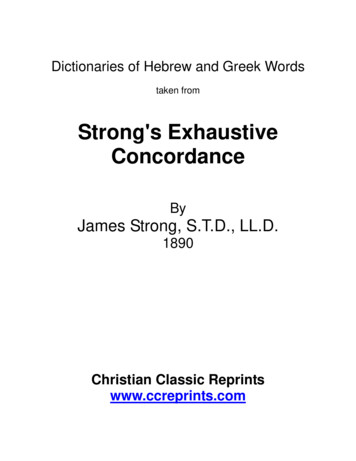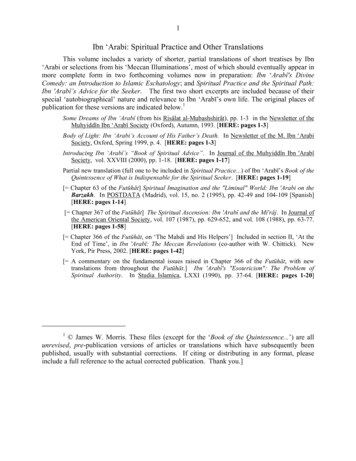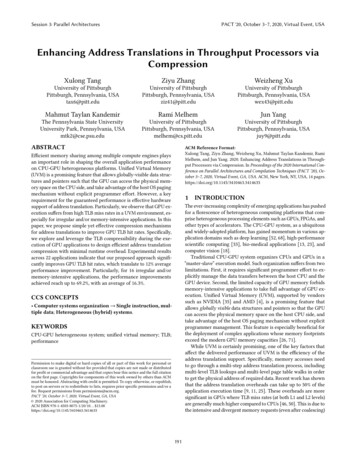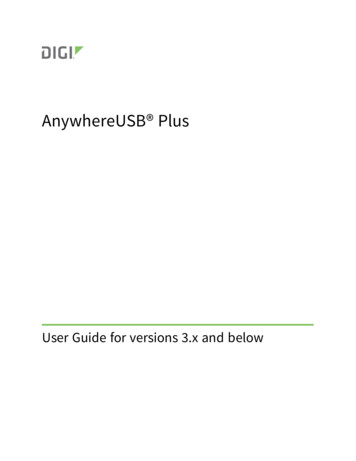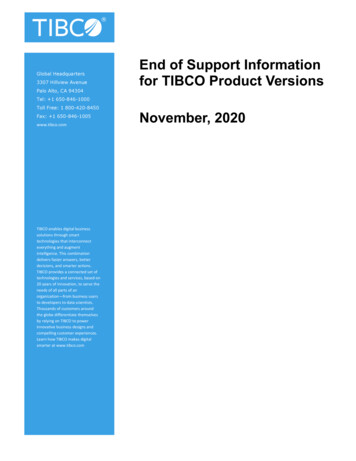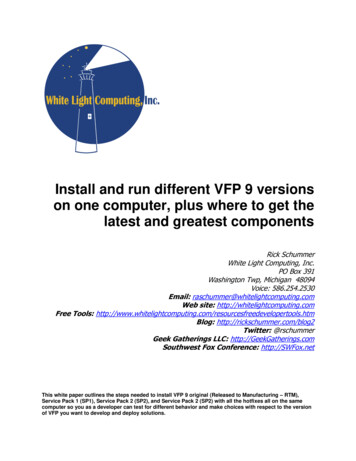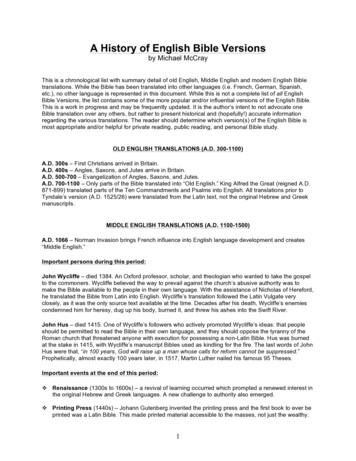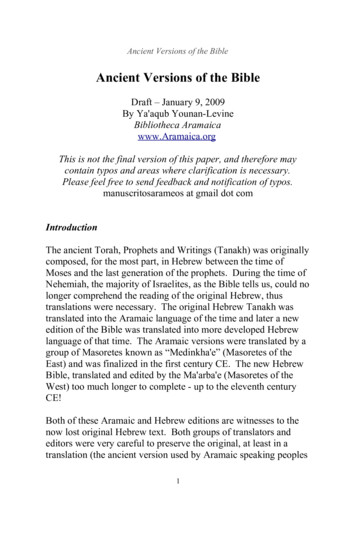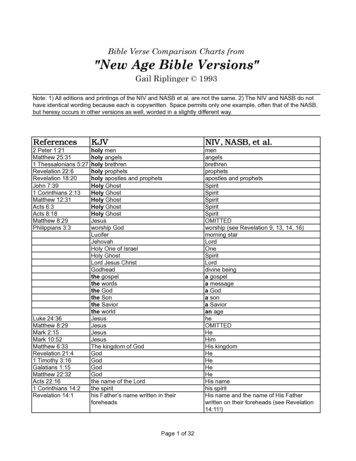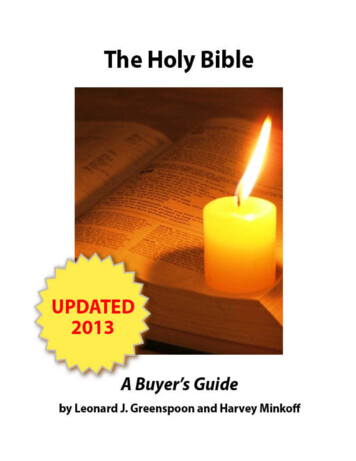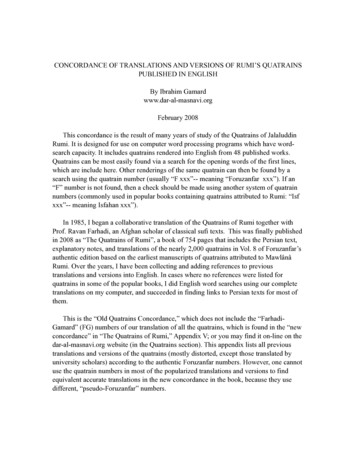
Transcription
CONCORDANCE OF TRANSLATIONS AND VERSIONS OF RUMI’S QUATRAINSPUBLISHED IN ENGLISHBy Ibrahim Gamardwww.dar-al-masnavi.orgFebruary 2008This concordance is the result of many years of study of the Quatrains of JalaluddinRumi. It is designed for use on computer word processing programs which have wordsearch capacity. It includes quatrains rendered into English from 48 published works.Quatrains can be most easily found via a search for the opening words of the first lines,which are include here. Other renderings of the same quatrain can then be found by asearch using the quatrain number (usually “F xxx”-- meaning “Foruzanfar xxx”). If an“F” number is not found, then a check should be made using another system of quatrainnumbers (commonly used in popular books containing quatrains attributed to Rumi: “Isfxxx”-- meaning Isfahan xxx”).In 1985, I began a collaborative translation of the Quatrains of Rumi together withProf. Ravan Farhadi, an Afghan scholar of classical sufi texts. This was finally publishedin 2008 as “The Quatrains of Rumi”, a book of 754 pages that includes the Persian text,explanatory notes, and translations of the nearly 2,000 quatrains in Vol. 8 of Foruzanfar’sauthentic edition based on the earliest manuscripts of quatrains attributed to MawlânâRumi. Over the years, I have been collecting and adding references to previoustranslations and versions into English. In cases where no references were listed forquatrains in some of the popular books, I did English word searches using our completetranslations on my computer, and succeeded in finding links to Persian texts for most ofthem.This is the “Old Quatrains Concordance,” which does not include the “FarhadiGamard” (FG) numbers of our translation of all the quatrains, which is found in the “newconcordance” in “The Quatrains of Rumi,” Appendix V; or you may find it on-line on thedar-al-masnavi.org website (in the Quatrains section). This appendix lists all previoustranslations and versions of the quatrains (mostly distorted, except those translated byuniversity scholars) according to the authentic Foruzanfar numbers. However, one cannotuse the quatrain numbers in most of the popularized translations and versions to findequivalent accurate translations in the new concordance in the book, because they usedifferent, “pseudo-Foruzanfar” numbers.
To explain the difficulty that arose in more detail: although academic translators suchas Annemarie Schimmel (1978), William Chittick (1983, 2004), and Franklin Lewis(2003 paperback edition, 2008) have used the world-wide standard numeration (of 1,983quatrains) based on Foruzanfar’s edition of the earliest texts of the Rumi’s Divan fromVolume Eight of the Quatrains (1963), most of the popular books (John Moyne,translating for Coleman Barks; Shahram Shiva, translating for Jonathan Star, forexample) have relied on a commercial one-volume edition of Foruzanfar’s work on theDivan (1957). The quatrains in this volume, however, are actually not those selected byForuzanfar, which he was not ready to publish for another six years. The commercialpublishers included an earlier edition of the quatrains done in Isfahan by MuhammadBaqir Ulfat, first published in 1941 (containing 1,994 quatrains alphabetized differentlyby the first letters in the opening lines, rather than the last letters for every letteredsection). And Ulfat’s “Isfahan” edition happened to have been used by the academicscholar A.J. Arberry (1949), so that the quatrain numbers used in the popular booksmatched the same quatrains translated by Arberry.The “Isfahan” edition numbers (in the form “Isf xxx”) are included for quatrainstranslated from this “pseudo-Foruzanfar” collection. In many cases, the texts are identicalto those Foruzanfar later included based on the earliest manuscripts. However, more oftenthere are minor or major differences of text, since the Isfahan edition is based on poorersources. Therefore, the notation “Isf xxx ( F xxx)” means equivalent texts, and notnecessarily identical texts. The Isfahan edition also includes many quatrains which arenot in the earliest manuscripts used by Foruzanfar. Since they are not in Foruzanfar’sauthentic edition, they are therefore not genuine quatrains composed by Rumi. Thenotation for these cases is “Isf xxx ( X) [NOT RUMI: NOT IN EARLIEST MSS].” Thisconcordance lists 140 of these quatrains which have been rendered into English.Also included are 108 cases in which I found that the quatrains attributed to Rumi inForuzanfar’s edition were actually composed before Rumi’s time (such as by Sanâ’î or Attâr). An additional quatrain, often attributed to Rumi (“Come, come, whoever youare”) but which is far older, is not in Foruzanfar’s edition but has been added in thelistings here. The notation for these cases is “[NOT RUMI: EARLIER POET]”. Thesemay have been quatrains which Rumi recited (and which he and his listeners knew werecomposed by others), but which ended up being attributed to him. In his translation ofexcerpts from the “Discourses” of Shams-i Tabrizi (“Me and Rumi”), William Chittickwrote about “floating quatrains”: “.well-known to scholars--poems of unknownauthorship that appear in slightly different versions in the divans of various poets.Although many of them are found among Rumi’s quatrains in the ‘Diwan-i Shams,’ thisdoes not suggest that either Rumi or Shams was the author. Certainly, it suggests thatRumi was not--that he had heard the verses from Shams, that he had then quoted them on
occasion, and that one of his disciples wrote them down as coming from his mouth” (“Meand Rumi,” pp. xxiii-xxiv). Many of these were found in “Nuzhatu ’l-Majâlis” (edited byMuhammad Amîn Riyâhî), a collection of quatrains compiled prior to 1284 C.E. I havenot included cases in which one half of a quatrain couplet (one of four lines) wascomposed by some earlier poet, and for which Rumi apparently composed the other threelines.In addition thre are 7 cases in which I found that the quatrains attributed to Rumi inForuzanfar’s edition were actually composed after Rumi’s time by his son, Sultan Walad.The notation for these cases is ”[NOT RUMI: LATER POET].”A distinction has been made between translators (who have translated directly fromPersian texts) and version-makers (who have produced versions based on the translationsfrom Persian done by others) by the notation “b/o” (meaning, “based on”). This isbecause many of the popular books of Rumi’s poetry often state “translated by so-and-so”when that person does not know Persian at all and his versions are based upon literaltranslations from Persian made by someone else. Non-scholars who are unable to read theoriginal Persian are advised to cautious regarding the accuracy of versions andtranslations made by non-scholars (including those made by Iranian Americans), whichoften have verses which are distorted or misunderstood when compared to the originalPersian. Since most of the quatrain versions and translations are of the “popular” kind,this unfortunately includes most of what has been published.Comparative quatrains are listed, according to Foruzanfar’s authentic numbers (withthe notation “F xxx”), which have been rendered into English by more than one translatoror version-maker.There are 900 quatrains in Foruzanfar’s edition that have not been published astranslations or versions.Suggestions and corrections to this Concordance are welcome. There may be anumber of cases in which the designation “NOT RUMI: NOT IN EARLIEST MSS” isincorrect because I was unable to locate a quatrain in Volume 8 of Foruzanfar’s editionwhen the equivalent text is actually there. For example, a quatrain in the pseudoForuzanfar edition (“Isf”) may end as ”-îda’ast” and judged as not found, but it exists in aform in the earliest manuscripts as ”-îd-ast.”ABBREVIATIONS
X absent from text; b/o based on (a version based on a literal translation); also in reprinted from an earlier bookArb Arberry’s “The Ruba’iyat of Jalal ad-Din Rumi”Arb DOR Arberry’s “Discourses of Rumi”Barks OS Barks’ “Open Secret”Barks UR Barks’ “Unseen Rain”Barks WAT Barks’ “We Are Three”Barks BR Barks’ “Birdsong: Rumi”Barks SIAY Barks’ “Say I Am You”Barks ER Barks’ “Essential Rumi”Barks IR Barks’ “Illuminated Rumi”Chittick SPL Chittick’s “The Sufi Path of Love”Chittick MAR Chittick’s “Me and Rumi”Chopra LPM Chopra’s “The Love Poems of Rumi”Chopra SL Chopra’s “The Soul in Love”dV-M de Vitray-Meyerovitch’s (French) translationsGlpn Golpinarli’s (Turkish) translationsHarvey LF Harvey’s “Love’s Fire”Harvey SF Harvey’s “Speaking Flame”Harvey LG Harvey’s “Love’s Glory”Harvey WP Harvey’s “Way of Passion”Helminski (KH) Helminski’s “The Knowing Heart”Helminski PRR Helminski’s “The Pocket Rumi Reader”Lewis (2000) Lewis’ “Rumi: Past and Present, East and West,” hardback editionLewis (2003) Lewis’ “Rumi: Past and Present.,” revised paperback editionLewis RSS Lewis’ “Rumi: Swallowing the Sun”Mafi-Kolin RWB Mafi and Kolin’s “Rumi: Whispers of the Beloved”Mafi-Kolin RHM Mafi and Kolin’s “Rumi: Hidden Music”Mafi-Kolin RGB Mafi and Kolin’s “Rumi: Gardens of the Beloved”Nich SP Nicholson’s “Selected Poems From the Divan.”Nich MOI Nicholson’s “The Mystics of Islam”Shiva RTV Shiva’s “Rending The VeilShiva HDSA Shiva’s “Hush-- Don’t Say Anything to God”Shiva RTS Shiva’s “Rumi: Thief of Sleep”Star GBP Star’s “Garden Beyond Paradise”Star IAB Star’s “In the Arms of the Beloved”QUATRAINS PUBLISHED IN ENGLISH
(1) Annemarie Schimmel, “The Triumphant Sun: A Study of the Works of JalâloddinRumi,” London: Fine Books, 1978. Total 11 quatrains, 18 half-quatrainsSchimmel p. 23, F 533: Who said: “The eternally Living is deadSchimmel p. 412, F 1565: As much as the cypress has an incomparable statureSchimmel p. 420, F 1037: The birds went screaming to SolomonSchimmel p. 422, F 686: You are not a peacock that one would look at your beautySchimmel p. 441, F 1375: When Syria and Iraq and LuristanSchimmel p. 443, F 717: I am the slave of those who know themselvesSchimmel p. 469, F 716: The day when your love makes me madSchimmel p. 469, F 569: When could the sun reach your countenance?Schimmel p. 471, F 317: He is our sun and stars and full moonSchimmel p. 473, F 346: My Beloved said: “How can that person be alive?Schimmel p. 473, F 1905: Neither am I I, nor are you you, nor are you ISchimmel p. 108, F 142 [lines three and four]: The elephant who yesternight saw India inhis dreamSchimmel p. 405, F 575 [lines three and four]: When soul and world become polluted bysorrowSchimmel p. 413, F 240 [lines three and four]: The lover’s soul is smiling like arosegardenSchimmel p. 411, F 579 [lines three and four]: By dint of the company of the rose, thethorn is safe from fireSchimmel p. 417, F 1342 [lines three and four]: I do not want a hare and do not catch agazelleSchimmel p. 421, F 1857 [lines one and two]: Hear the secrets from the Divinely inspiredparrotSchimmel p. 422, F 874 [lines one and two]: When I plant roses without you, only thornsgrowSchimmel p. 427, F 1161 [lines three and four]: The pupil of my eye became restless in(beholding) your faceSchimmel p. 427, F 689 [NOT RUMI: EARLIER POET]: O soul, sugar is procured fromthe reed with cautionSchimmel p. 428, F 212 [lines three and four]: I said: ‘Do you not give me a portion ofthis sugar?’Schimmel p. 441, F 1360 [lines three and four]: I am not an enemy, as much as I lookenemy-likeSchimmel p. 443, F 442 [lines three and four]: He dived into the ocean of his own nonexistenceSchimmel p. 445, F 1094 [lines one and two]: He who does not smile like the rose at thesight of the friend
Schimmel p. 458, F 1173 [lines one and two]: I am the servant of the Koran as long as Iam alive, I am the dust of the road of the elect MohammadSchimmel p. 461, F 898 [lines three and four]: The world may be well heated by your fireSchimmel p. 462, F 600 [NOT RUMI: EARLIER POET] [lines three and four]: A dervishis not he who seeks breadSchimmel p. 465, F 804 [NOT RUMI: EARLIER POET] [lines one and two]: As long asmadrasa and minaret are not destroyed, the ‘state’ of the qalandar will not becomeflourishingSchimmel p. 468, F 166 [lines three and four]: The beloved woman is a pretext-- theBeloved is GodSchimmel p. 474, F 941 [NOT RUMI: EARLIER POET] [lines three and four]: As longas I am with you, my metaphorical act is all prayer(2) William Chittick, “The Sufi Path of Love: The Spiritual Teachings of Rumi,” Albany,New York: State University of New York, 1983. Total 8 quatrainsChittick SPL p. 200, F 398: Old women’s words cannot hold us backChittick SPL p. 297, F 618: No one becomes aware of that royal presenceChittick SPL p. 297, F 904: Since the idol is Thy Face, idolatry is sweeterChittick SPL p. 298, F 1166 [NOT RUMI: EARLIER POET]: Thy Face made me acontinual rosegardenChittick SPL p. 298, F 57: He who painted you all by HimselfChittick SPL p. 299, F 619: With Thy Face, does anyone think about gardens?Chittick SPL p. 302, F 581: For him who has the mote of a heart in his breastChittick SPL p. 303, F 1692: I asked for one kiss, and Thou gavest me six!(3) A. J. Arberry, “The Rubâ’îyât of Jalâl ad-Dîn Rûmî: Select translations into EnglishVerse,” London: Emery Walker, Ltd., 1949. Total 359 quatrainsArb p. 3a, Isf 1331 ( F 1173): So long as I shall live To God’s Koran my faith I giveArb p. 3b, Isf 1374 ( F 1336): Once more, O King, Accept the service that I bringArb p. 4a, Isf 1840 ( F 1715): When Thou madest me to tread On the path of faithArb p. 5a, Isf 65 ( F 38): Time bringeth swift to end The rout men keepArb p. 5b, Isf 175 ( F 206): Be just: confess In love is ample righteousnessArb p. 6a, Isf 223 ( F 405): Thou art so knitted to thy soul, That but two days continuethArb p. 6b, Isf 816 ( F 464): The man whose soul is wrought With Yea and Nay contentArb p. 7a, Isf 1568 ( F 1557): In thy fancy’s lane Why dost thou groping go
Arb p. 7b, Isf 1463 ( F 1
www.dar-al-masnavi.org February 2008 This concordance is the result of many years of study of the Quatrains of Jalaluddin Rumi. It is designed for use on computer word processing programs which have word-search capacity. It includes quatrains rendered into English from 48 published works. Quatrains can be most easily found via a search for the opening words of the first lines, which are .

